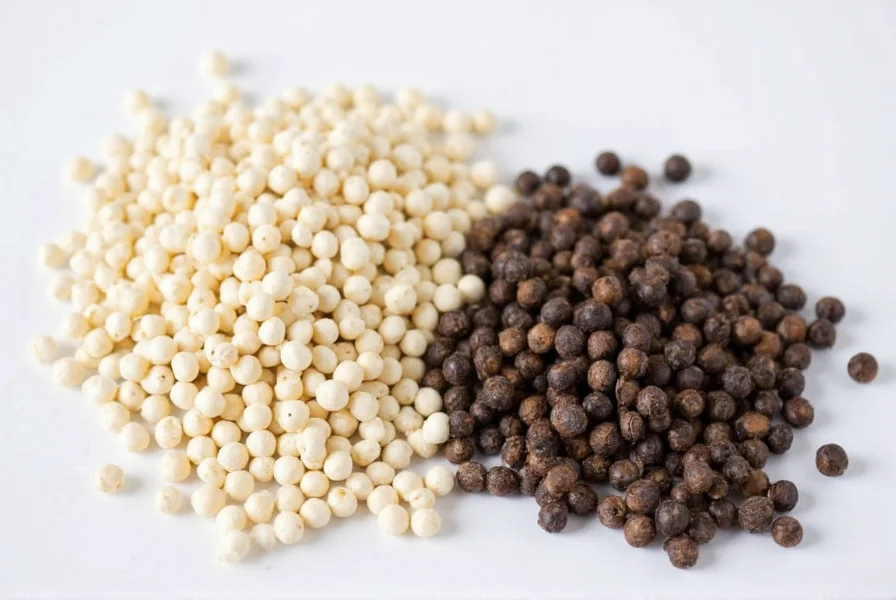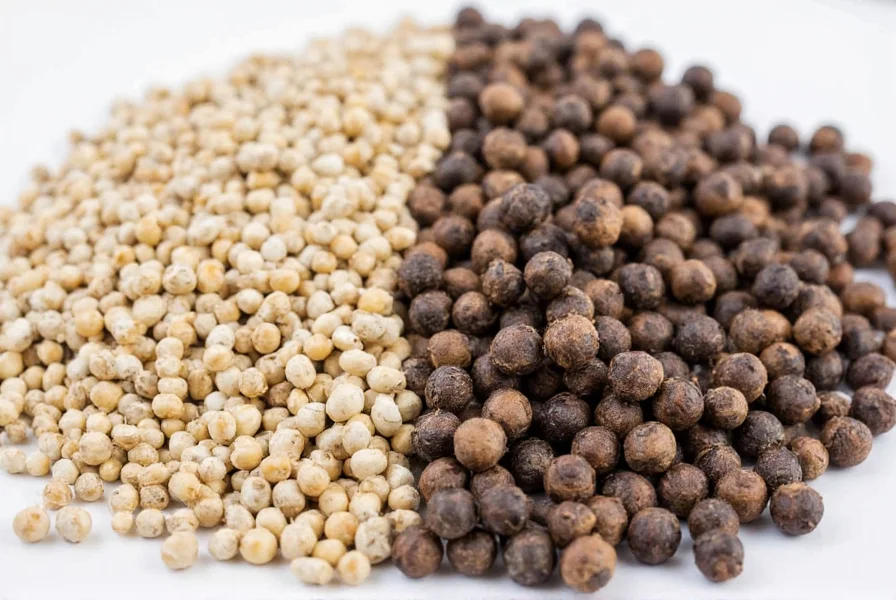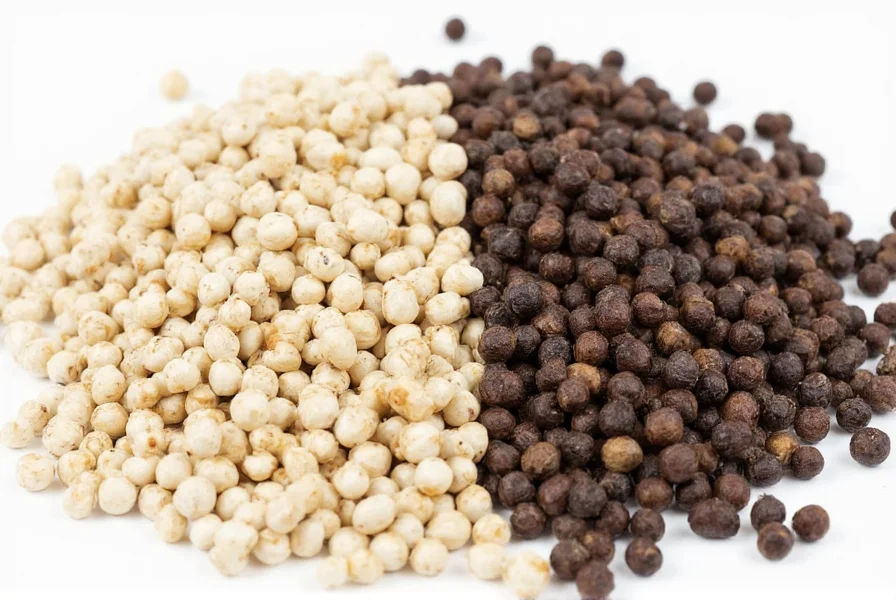Understanding the distinction between these two common spices helps elevate your cooking and make more informed choices in the kitchen. While they share the same botanical origin, the transformation from peppercorn to finished spice creates dramatically different culinary experiences.
Origin and Production Process
Both white and black pepper derive from the Piper nigrum vine, native to South India but now cultivated throughout tropical regions. The critical difference emerges during harvesting and processing:
Black pepper begins as green, unripe peppercorns. These are briefly cooked in hot water, then spread out to dry in the sun. During this drying process, the outer layer (pericarp) turns black through enzymatic oxidation, similar to how an apple browns when exposed to air. The resulting wrinkled, dark berries contain both the outer skin and inner seed.
White pepper starts as fully ripe red peppercorns. After harvesting, these ripe berries undergo a process called retting—soaking in water for about a week—which softens and removes the outer skin. What remains is the inner seed, which is then dried to produce smooth, pale white peppercorns. This additional processing step explains why white pepper typically costs more than black pepper.
| Characteristic | Black Pepper | White Pepper |
|---|---|---|
| Peppercorn Stage | Unripe (green) | Fully ripe (red) |
| Processing Method | Cooked and sun-dried with outer layer intact | Outer layer removed through retting before drying |
| Flavor Profile | Sharp, pungent, complex with floral notes | Milder, earthier, more medicinal |
| Aroma | Strong, woody, citrusy | Subtler, mustier |
| Color Impact | Visible black specks | No visible specks |
| Typical Culinary Use | General seasoning, visible in dishes | Cream sauces, light-colored dishes |
Flavor Profile Comparison
The most significant practical difference between white and black pepper lies in their flavor characteristics. Black pepper delivers a more complex flavor experience with its signature pungency from piperine, the compound responsible for pepper's heat. It offers citrusy, floral, and woody notes alongside its sharp bite. When freshly ground, black pepper releases volatile oils that create an aromatic experience you simply don't get with pre-ground versions.
White pepper provides a different sensory experience. Without the outer layer containing many aromatic compounds, white pepper has a more singular, earthy flavor with subtle fermented notes from the retting process. Its heat is more direct and lingers longer on the palate without the complex top notes of black pepper. Many describe white pepper as having a slightly musty or medicinal quality that becomes more pronounced when used excessively.
Chefs often note that black pepper's flavor develops more gradually when cooked, while white pepper's heat can intensify with prolonged cooking time—a crucial consideration when planning dish preparation.
Culinary Applications and When to Use Each
Professional chefs select between white and black pepper based on both flavor considerations and visual presentation. Understanding when to use white pepper versus black pepper can transform your cooking results.
Black pepper shines in most applications where its visual presence isn't problematic. It's ideal for:
- Meat rubs and marinades
- Steak seasoning (particularly as part of a mignonette)
- Roasted vegetables
- Tomato-based sauces
- Vinaigrettes and dark-colored soups
White pepper proves invaluable in specific culinary situations where appearance matters:
- Cream sauces and soups (béchamel, alfredo, velouté)
- Potato salad and other light-colored salads
- Seafood dishes where black specks would be visually disruptive
- Traditional Chinese cuisine (particularly in clear soups)
- Some European dishes like vichyssoise
Many professional kitchens maintain both varieties because certain dishes simply demand one or the other. For example, a classic béarnaise sauce would be ruined visually by black pepper specks, while a robust beef stew benefits from black pepper's complex flavor profile.
Nutritional Content and Health Benefits
Both pepper varieties offer similar nutritional profiles since they come from the same plant. The primary bioactive compound, piperine, exists in both but in slightly different concentrations. Black pepper typically contains about 4-10% piperine by weight, while white pepper may have marginally less due to the removal of the outer layer where some compounds concentrate.
Piperine enhances the absorption of certain nutrients and compounds, including curcumin from turmeric. This pepper nutrient absorption benefit applies to both varieties, though some studies suggest black pepper might be slightly more effective due to its broader spectrum of volatile compounds.
Both types contain trace minerals like manganese, iron, and potassium, along with small amounts of vitamin K. Neither variety significantly impacts daily nutritional requirements when used in typical culinary amounts, but both contribute to the growing body of research on spice-related health benefits.
Price, Availability, and Storage Considerations
White pepper generally costs 20-50% more than black pepper due to its more labor-intensive production process. The additional steps of waiting for full ripening and removing the outer layer increase production costs significantly.
For optimal flavor preservation, store both varieties in airtight containers away from light and heat. Whole peppercorns maintain their potency for 2-3 years, while pre-ground pepper loses its volatile oils within 3-6 months. Serious cooks always recommend buying whole peppercorns and grinding them fresh—this applies equally to both white and black varieties.
When shopping for pepper, look for uniform color and size. High-quality black peppercorns should be dark and slightly shiny, while good white peppercorns appear creamy white without dark spots that indicate incomplete skin removal.
Common Misconceptions About Pepper Varieties
Several myths persist about the differences between white and black pepper. One common misconception is that white pepper is "stronger" than black pepper. In reality, black pepper typically contains more piperine and delivers a more complex heat experience, while white pepper's heat feels different due to the absence of other flavor compounds.
Another misunderstanding involves the notion that white pepper is somehow "purer" or more refined. Both varieties undergo processing—the difference lies in which parts remain, not in any inherent superiority of one over the other.
Understanding these facts helps cooks make informed decisions rather than following culinary folklore when choosing between white and black pepper for specific recipes.

Practical Tips for Home Cooks
When substituting one pepper for another, remember that they aren't directly interchangeable due to their flavor differences. As a general rule, use about 25% less white pepper when substituting for black pepper, as its flavor can become overpowering more quickly in certain dishes.
For the most vibrant pepper flavor, grind your own from whole peppercorns. A quality pepper mill makes a noticeable difference in both aroma and taste compared to pre-ground options. Consider keeping separate grinders for white and black pepper to prevent cross-contamination of flavors.
Experiment with both varieties in your cooking to develop your palate for their distinct characteristics. Try making two versions of the same dish—one with black pepper and one with white—to truly appreciate the flavor difference between white and black pepper in practical application.

What is the main difference between white and black pepper?
The main difference lies in their processing method. Black pepper comes from unripe green peppercorns that are cooked and dried with their outer layer intact, while white pepper is made from fully ripe peppercorns with the outer layer removed through retting before drying. This processing difference creates distinct flavor profiles and appearances despite both coming from the same plant (Piper nigrum).
Why does white pepper taste different from black pepper?
White pepper tastes different because it lacks the outer layer (pericarp) of the peppercorn that contains many aromatic compounds. Without this layer, white pepper has a more singular, earthy flavor with subtle fermented notes from the retting process, while black pepper offers a complex profile with citrusy, floral, and woody notes alongside its sharp bite. The heat in white pepper also tends to linger longer on the palate.
When should I use white pepper instead of black pepper?
Use white pepper in light-colored dishes where black specks would be visually disruptive, such as cream sauces, potato salad, seafood dishes, and traditional Chinese clear soups. Black pepper works better in most other applications including meat rubs, tomato-based sauces, roasted vegetables, and vinaigrettes where its visual presence isn't problematic and its complex flavor can shine.
Is white pepper healthier than black pepper?
Both varieties offer similar nutritional benefits since they come from the same plant. Black pepper typically contains slightly more piperine (4-10% by weight) than white pepper, which may make it marginally more effective at enhancing nutrient absorption. Neither variety provides significant nutritional value in typical culinary amounts, but both contribute to potential health benefits associated with spice consumption.
Why is white pepper more expensive than black pepper?
White pepper costs 20-50% more than black pepper due to its more labor-intensive production process. It requires waiting for peppercorns to fully ripen, then soaking them to remove the outer layer before drying the inner seed. This additional processing increases production costs significantly compared to black pepper, which involves simply cooking and drying unripe peppercorns with their outer layer intact.











 浙公网安备
33010002000092号
浙公网安备
33010002000092号 浙B2-20120091-4
浙B2-20120091-4